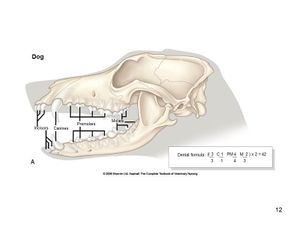Difference between revisions of "Dental Formula - Dog"
Jump to navigation
Jump to search
Ggaitskell (talk | contribs) |
Ggaitskell (talk | contribs) |
||
| Line 9: | Line 9: | ||
Formula for '''permanent''' teeth: 2 (I3/3 C1/1 P4/4 M2/3) | Formula for '''permanent''' teeth: 2 (I3/3 C1/1 P4/4 M2/3) | ||
| + | |||
====Canine Teeth==== | ====Canine Teeth==== | ||
Revision as of 07:15, 9 September 2014
Overview

Image from Aspinall, The Complete Textbook of Veterinary Nursing, Elsevier Health Sciences, All rights reserved
Dogs are toothless at birth. The deciduous teeth are complete and functional within 2 months of birth in most breeds. Permanent teeth are complete and funtional by the end of the 7th month.
Formula for deciduous teeth: 2 (i3/3 c1/1 p3/3)
Formula for permanent teeth: 2 (I3/3 C1/1 P4/4 M2/3)
Canine Teeth
The canine teeth are large, curved and laterally compressed. Their root is longer than their crown. They have a single root.
Incisors
Incisors have a single root.
Premolars
Premolars are irregular and closely-spaced. They are more complex and larger caudally.
Molars
The molars are broader than the premolars. The large flat surface is used for grinding.
Breed Differences
Eruption times differ between breeds so it is difficult to age dogs by their teeth.
| Dental Formula - Dog Learning Resources | |
|---|---|
Anatomy Museum Resources |
Image - Canine Dentition |
Error in widget FBRecommend: unable to write file /var/www/wikivet.net/extensions/Widgets/compiled_templates/wrt662bb1ac99c046_09859478 Error in widget google+: unable to write file /var/www/wikivet.net/extensions/Widgets/compiled_templates/wrt662bb1ac9cf1f7_88146448 Error in widget TwitterTweet: unable to write file /var/www/wikivet.net/extensions/Widgets/compiled_templates/wrt662bb1aca007b1_98955762
|
| WikiVet® Introduction - Help WikiVet - Report a Problem |